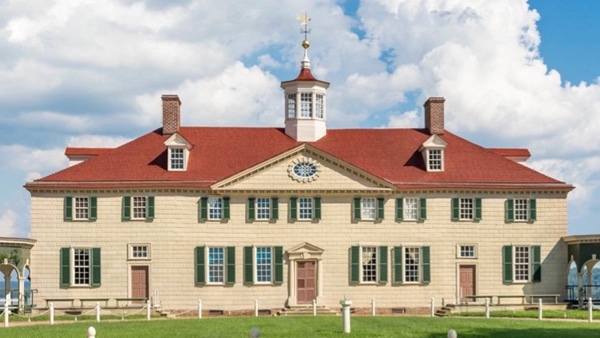By Ambassador Callista L. Gingrich and Speaker Newt Gingrich
Every American should visit George Washington’s Mount Vernon, whether on Presidents’ Day or any time of year.
Located 15 miles south of Washington on a gorgeous section of the Potomac River, Mount Vernon is an American treasure. The original house was built in 1674 and then modernized and expanded by George Washington in 1761. Washington himself loved Mount Vernon and spent as much time there as he could. It was fitting that he died there in 1799.
When you walk into the Mount Vernon estate, you are walking into one of the great sites of American history. You are walking the grounds of the general who won the Revolutionary War, the man who presided over the Constitutional Convention (which gave us the structure of government that still protects us 247 years later), and the first President of the United States.
Washington was a giant physically and morally. He was large for his time (today an NFL offensive tackle would be a comparable size for our generation). Despite his size, he was considered one of the best horsemen in America. His strong, reserved, disciplined personality and deep commitment to honor and duty made him outstanding – even in a generation of remarkable leaders.
Washington’s austere aloofness was illustrated when Gouverneur Morris (who was also tall for the era) bet Alexander Hamilton a dinner that he could slap Washington on the shoulder and greet him informally. Morris did so, but a moment later he quailed and retreated. At the dinner which Hamilton threw for Morris, one account reports Morris said, “I have won the bet but paid dearly for it, and nothing could induce me to repeat it.”
Washington’s sense of duty may have been captured best when, after winning the Revolutionary War against Great Britain, he addressed the Continental Congress at the State House in Annapolis, Maryland (which is now known as the Old Senate Building). There, he voluntarily resigned his military commission and returned to private life.
According to Washington’s Ambassador to Great Britain, Rufus King, George III on hearing about this act of grace reportedly expressed to American portrait artist Benjamin West, “that act closing and finishing what had gone before and viewed in connection with it, place him in a light the most distinguished of any man living, and that [King George] thought [Washington] the greatest character of the age.”
Gordon S. Woods, one of the greatest historians of the modern era wrote in “The Radicalism of the American Revolution” that: “George Washington, of course, was the perfect Cincinnatus, the Roman patriot that returned to his farm after his victories in war. … The greatest act of his life, the one that gave him his greatest fame, was his resignation as commander in chief of the American forces.”
Washington was perhaps our most noble, patriotic, founding father. Without him, we probably would not have become a country. When you visit his home, you are visiting the closest thing American history has to hallowed ground – followed perhaps by the battlefield at Gettysburg.
The mansion and 30 additional buildings cover 500 acres and are a refuge of patriotism and calm. Visiting Mount Vernon gives you a chance to imagine what Washington was like, how he lived, and the nature of his commercial farming activities.
Washington and his wife Martha hosted visitors constantly. In 1794 – five years before his death – Washington wrote that he did not mind if people wanted to visit just out of curiosity. He knew that he had become a symbol of the new country. If hosting people would help bind the new nation together, he was willing to entertain a seemingly endless stream of visitors.
In addition to the historic buildings, there is an essential education center to see. Young people will find Washington’s false teeth fascinating. There are video presentations that are enormously helpful in explaining his life (which in many ways mirrored the life of the emerging America).
The various stories about Washington are vividly described (and in some cases enacted). They helped inspire three novels Newt wrote with Bill Forstchen and Steve Hanser – “To Try Men’s Souls,” “Valley Forge,” and “Victory at Yorktown.” Mount Vernon was also essential in making “The First American,” our documentary film about the life and legacy of George Washington.
You will be amazed by how much you learn from the education center and beautiful walking tour. You can visit the mansion and the graves of George and Martha Washington. You can walk through the farm and enjoy farm animals and a magnificent view of the Potomac (where Washington had a commercial fishery). You can also see the slave quarters and their cemetery to get a full understanding of the faults, challenges, and contradictions that existed in early America. Even the forests around the grounds are preserved as they were when Washington would have walked through them.
For more scholarly types, there is a remarkable Presidential Library. Washington was the only President who did not have a formal Presidential Library until the Mount Vernon Ladies Association built one in 2013 while our good friend Gay Gaines was serving as regent. This remarkable group has preserved and privately operated Mount Vernon – without receiving federal funding – since 1858. Importantly, this means Mount Vernon is open to the public on federal holidays – including Presidents’ Day. The MVLA is an indispensable defender of patriotism and its work is an amazing model of how volunteerism can replace government bureaucracies.
So, as you and your family observe Presidents’ Day this year, make plans to visit Mount Vernon and explore the life and legacy of George Washington.


